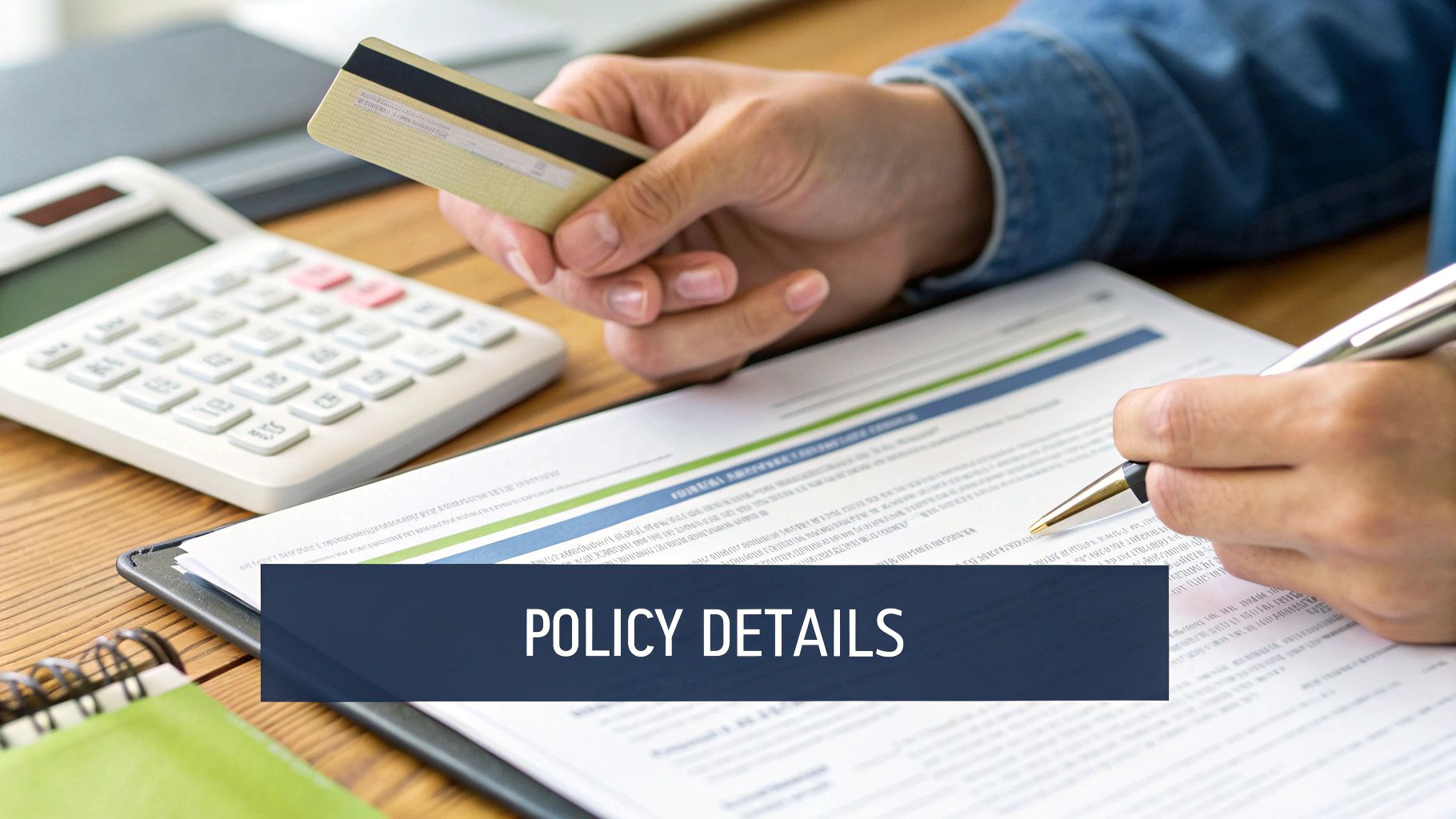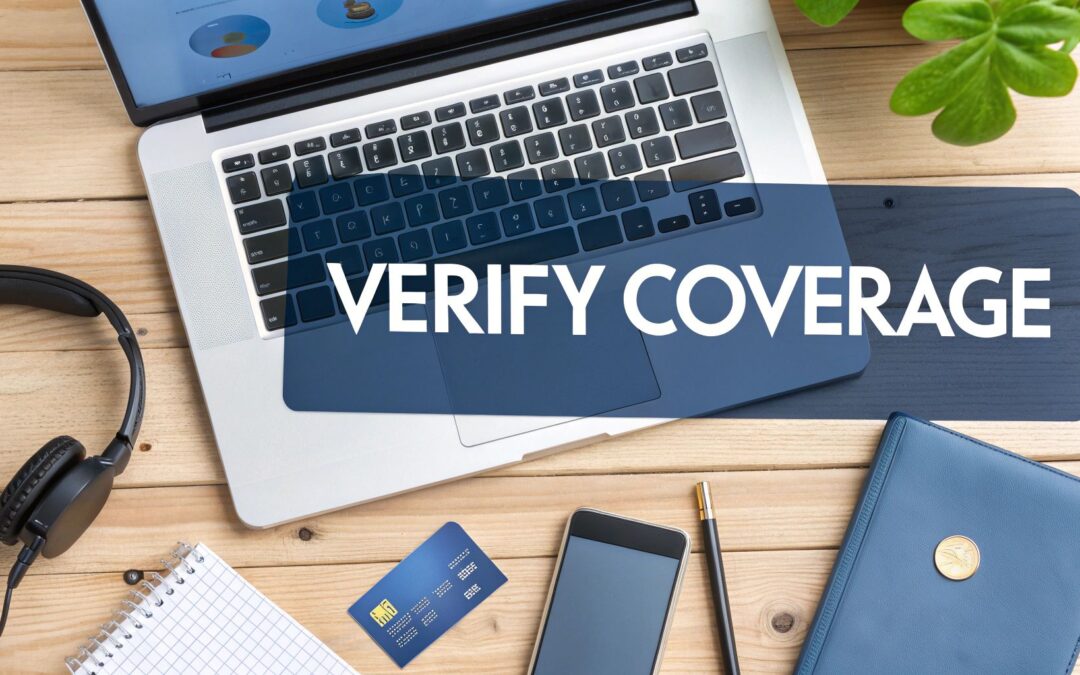Before you book that appointment or give the green light for a repair, there's one small but crucial step you can't afford to skip: verifying your insurance coverage. Overlooking this can turn a simple doctor's visit or a minor car repair into a massive financial headache, leaving you with unexpected bills and denied claims.
Why Verifying Your Insurance Is a Non-Negotiable First Step

Assuming your insurance will automatically cover something is a risky gamble. Whether it's a routine check-up, a specialist consultation, or repairs after a fender bender, taking a few minutes to verify your benefits puts you in control. It's the difference between navigating the system confidently and making a costly mistake.
The world of insurance is only getting more complex. The global market for insurance eligibility verification is projected to grow from $2.1 billion in 2024 to a staggering $3.18 billion by 2029, a clear sign of how essential this process has become for everyone involved.
Understanding what's at stake is the first move toward making smarter financial choices. Being proactive not only protects your wallet but ensures you get the care or service you need without any nasty surprises down the road. This is especially critical when you realize that medical emergencies without insurance can ruin you financially.
Taking a moment to confirm your coverage details isn't just about paperwork; it's about peace of mind. It shifts you from being a passive patient to an informed consumer who is in charge of their own healthcare journey. This simple action is your best defense against unexpected out-of-pocket costs.
Gathering Your Essential Insurance Information

Before you can check on your coverage, you need to have the right details ready to go. Think of it like a scavenger hunt where you already have the map—it just makes everything faster and a lot less frustrating.
Your most important tool? That little plastic card in your wallet.
While every insurance card looks a bit different, they all contain the key identifiers that unlock your policy details. You'll almost always find these three critical numbers:
- Member ID Number: This is your unique code, assigned specifically to you or a family member on the policy.
- Group Number: If you get insurance through work, this number identifies your employer's plan.
- Policy Number: This is the master number for the entire insurance contract itself.
Having these numbers handy is a non-negotiable first step. Whether you're logging into an online portal or dialing a customer service line, it's the fastest way for anyone to pull up your file.
Beyond the Insurance Card
Your card is the key, but other documents unlock the full story of your benefits. For health insurance, the Summary of Benefits and Coverage (SBC) is pure gold. This document breaks down exactly what you'll pay for different services—like deductibles and copayments—in a simple, standardized format.
For auto or home insurance, the equivalent is your declarations page. It's a one-page snapshot of your policy, outlining coverage limits, deductibles, and any special add-ons you have. Knowing what documents you need to get insurance from the very beginning puts you in a much stronger position.
Pro Tip: Save digital copies of your insurance card, SBC, and declarations page to a secure folder on your phone or in the cloud. It’s the 21st-century version of keeping your card in your wallet, ensuring you have critical info at your fingertips—especially during an emergency.
Using Online Portals for Instant Answers
Forget waiting on hold. In most cases, the fastest way to get answers about your insurance is right at your fingertips. Your insurer's online portal or mobile app is designed to give you 24/7 access to your policy details. Getting set up is usually as simple as registering an account with your member ID and a few personal details.
Once you’re in, the first thing you should look for is your benefits dashboard or coverage summary. Think of this as your command center. It gives you a clear, at-a-glance overview of your plan’s most important numbers—like your annual deductible, copay amounts, and your out-of-pocket maximum.
Navigating Your Benefits Dashboard
Let's say you need to know if your plan covers physical therapy. Instead of picking up the phone, you can use the portal’s search bar or benefits lookup tool. These features let you check coverage for specific procedures or find in-network providers in just a few clicks. It turns a 20-minute phone call into a two-minute search.
Insurers are pouring money into making these platforms smarter. In the U.S. healthcare sector alone, electronic eligibility systems now handle over 1.2 billion transactions every year, which helps cut down on costly errors. This tech-forward push is because AI-driven verification can slash claims processing time by up to 30%, according to a global insurance report from BlackRock.
Your online portal is more than just a place to check benefits—it's your digital proof of insurance. Most portals let you download or print a temporary ID card, which can be a lifesaver if you ever leave your physical card at home.
The entire dashboard is built to give you a high-level view of your plan's structure.
As you can see, a typical interface is designed to guide you straight to the most critical information—benefits, claims, and provider networks—so you can get answers on your own time.
Troubleshooting Portal Problems
Of course, not all portals are created equal. If the dashboard feels confusing and you can’t find what you need, hunt for a "documents" or "plan materials" section. This is usually where the company stashes the full policy details, including the official Summary of Benefits and Coverage (SBC).
Understanding these documents is a huge part of picking the right policy in the first place, which is why we put together a guide on how to compare health insurance plans. If you've tried everything and are still stuck, look for a secure messaging feature. It’s a great way to ask a specific question and get a response in writing.
Getting Clear Answers Directly from Your Insurer
Online portals are great for a quick look, but let's be honest—sometimes you need to talk to a real person. When you need absolute clarity on a specific procedure or want to understand the nitty-gritty of your coverage, picking up the phone is still your most powerful tool.
It’s the surest way to get definitive answers right from the source. Before you dial that member services number on the back of your card, make sure you have your policy information handy. Speaking to someone live lets you ask follow-up questions in real-time and cut through the confusion.
This little decision tree shows how a simple login attempt can point you in the right direction.

As the graphic shows, if you hit a wall online or just don't feel confident in the information you're seeing, it’s time to call.
Making the Call Productive
To get the most out of your conversation, you need to go in prepared. Instead of asking a vague question like, "Is my surgery covered?" you’ll get a much better answer if you’re specific.
Try this: "I'm scheduled for procedure code [get this from your doctor's office] with Dr. Smith. Can you confirm this is a covered benefit under my plan and that Dr. Smith is an in-network provider?" Now that’s a question they can answer clearly.
When you have a representative on the line, you want to be ready with a few targeted questions to make sure nothing falls through the cracks. This table outlines some of the most important things to ask to get a complete picture of your coverage.
Key Questions to Ask Your Insurance Representative
| Question Category | Sample Question to Ask |
|---|---|
| Pre-Authorization | Does this specific service or procedure require pre-authorization before I schedule it? |
| Deductible Status | Can you tell me what my remaining annual deductible is for this year? |
| Out-of-Pocket Costs | What will my estimated copayment or coinsurance be for this visit with an in-network provider? |
| Provider Network | I want to confirm that [Doctor’s Name or Hospital Name] is considered in-network for my plan. Is that correct? |
| Specific Coverage | I was prescribed [Medication Name] or need [Test Name]. Can you confirm it's covered and what my cost will be? |
Running through these questions ensures you hang up the phone with actionable information, not more confusion.
Crucial Tip: Always, always document your call. Before you hang up, ask for the representative's name and a call reference number. Jot down the date, time, and a quick summary of what you discussed. This simple step can save you from major headaches if a coverage dispute comes up later.
This documentation isn't just for your records; it's your proof that you did your due diligence. It turns a simple phone call into a powerful tool, solidifying your understanding of how to verify insurance coverage and ensuring you get the benefits you pay for.
How Service Providers Handle Verification on Their End
When you slide your insurance card across the counter at a doctor’s office or auto shop, you're setting a whole other process in motion behind the scenes. Providers don't just take your card at face value—they have to confirm everything directly with your insurer in real-time.
This is called insurance eligibility verification, and it’s a non-negotiable step for their business. It's how they make sure they'll get paid for their services. Using the member and group ID numbers from your card, they check if your policy is active, confirm your copay and deductible amounts, and see if any services need pre-authorization.
Even a simple typo in your name or policy number can trigger a denial on their end. That’s why having your information 100% accurate is so important.
When Verification Fails
So, what happens if the front desk staff tells you they can’t confirm your coverage? First off, don't panic. This happens more often than you'd think. It could be a simple system glitch, outdated information in their records, or maybe a recent change to your plan hasn't filtered through all the systems yet.
Your first move should be to point them to the customer service number on the back of your card. You can even offer to call your insurer right then and there to sort it out together. Knowing what to do if your doctor doesn't accept your health insurance gives you a clear playbook for these awkward moments.
This verification step is crucial on a global scale, especially where major insurance coverage gaps exist. For natural disasters, this gap hit roughly 60% in 2023, which shows the massive financial risk people and businesses face when coverage isn't properly in place and confirmed.
To keep things running smoothly, many providers now use sophisticated tools to manage these verifications, from automated systems to even AI receptionist solutions for insurance agents. The more you understand their side of the process, the better you can work with them to make sure your benefits are always applied correctly.
Common Questions About Insurance Verification
Even when you have all your ducks in a row, questions are bound to pop up. That’s just the nature of insurance. Having clear answers ahead of time can turn a moment of confusion into one of confidence.
A big one we hear all the time is, "How often should I even be checking my coverage?" It's a great question. A good rule of thumb is to verify at the start of a new plan year, before any major medical procedure, or anytime you switch jobs. For routine stuff, like a yearly check-up with your regular doctor, once a year is probably fine. But if you’re seeing a new specialist? Always, always verify before you go.
Eligibility Versus Benefits
This is a trip-up point for so many people, but it’s crucial to get it right. It’s the difference between knowing you have a policy and knowing what that policy actually does for you.
- Eligibility Check: This is the most basic confirmation. It just says, "Yes, your policy is active today." That's it.
- Benefits Verification: This is the deep dive. It tells you the important stuff—what your copay is, how much deductible you have left, and whether a service needs that dreaded pre-authorization.
Don't settle for a simple eligibility check. Always push for a full benefits verification. It's the only way to get a real picture of what you'll actually have to pay.
So what happens when your doctor’s office and your insurance company are telling you two different things? It’s frustrating, but you can solve it. Ask your insurer for written confirmation of your benefits for that specific service. Take that document straight to the provider's billing office. If you’re still getting pushback, ask for a three-way call with you, the provider, and an insurance rep to get everyone on the same page.
A common point of confusion is verifying coverage for family members. If you're the primary policyholder, you can verify benefits for a spouse or dependent on your plan. You’ll just need their name, date of birth, and member ID to get started.
Finally, remember that the devil is in the details. Policies can get incredibly specific, especially when it comes to situational claims like property damage. For a look at how detailed these can get, you can find helpful answers to specific questions about water damage insurance coverage. Honestly, knowing what to ask is half the battle.
Navigating the world of insurance can feel overwhelming, but you don't have to do it alone. At My Policy Quote, we specialize in helping individuals and families find the perfect coverage to fit their unique needs and budget. Explore your options and get the clarity you deserve by visiting us at https://mypolicyquote.com.


